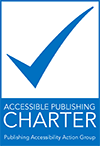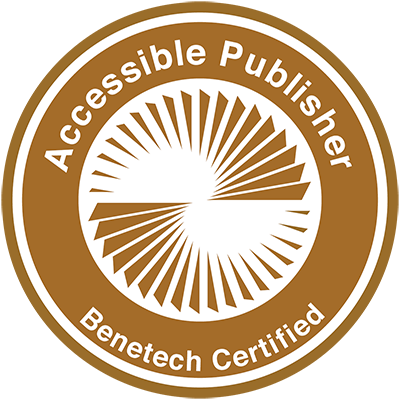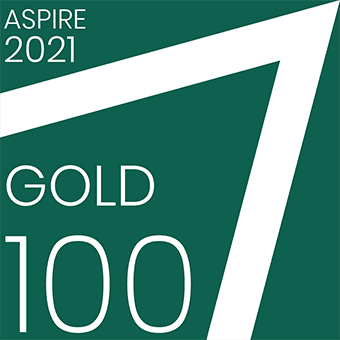This statement was prepared in January 2020. It was last updated on 10 April 2024.
Taylor & Francis is committed to ensuring all our products, platforms and websites are accessible to as wide an audience as possible. We are continually improving the quality and accessibility of our content, to address the needs of all customers, and support them to reach their highest potential.
To guide us in our efforts, we use the Americans with Disabilities Act of 1990, the US Government Section 508 Standards, EPUB Accessibility 1.1 (w3.org) and W3C’s Web Content Accessibility Guidelines (WCAG) 2.0/2.1. We are working toward the A and AA compliance levels of the WCAG 2.1.
Taylor & Francis is a Global Certified Accessible™ (GCA) publisher. Read more about GCA on the Benetech website.
Taylor & Francis are pleased to have obtained an ASPIRE Publisher score of 100%, which is the Gold ranking for accessibility statement verification. Please take a moment to read our ASPIRE Story.


Taylor & Francis has signalled its ongoing commitment to accessibility by signing the Accessible Books Consortium (ABC) and Publishing Accessibility Action Group UK (PAAG) charters.
Working with the Accessible Community
Taylor & Francis is proud to partner with advocates of accessibility, including BookShare in the USA and Royal National Institute of Blind People (RNIB) in the UK, and the AccessText Network, which provides accessible materials to students at post-secondary institutions in the USA and Canada.
All of these partnerships offer a direct path to enable students with a print or visual impairment to participate in classroom lectures alongside their peers, through direct access to content, which is DRM-free.
As our books publish, the eBooks automatically distribute to these 3 channels, ensuring the content is immediately available to customers. Between these three partnerships, 95% of our eBook catalogue is available in PDF or ePub formats globally.
Alternative Text
As part of our commitment to WCAG A-level compliance, Taylor & Francis introduced alternative text into our eBook workflows in 2020. More than 6,000 titles have been published with alternative text and hundreds more are In Production as of April 2024. Long descriptions are supplied where necessary, for more complex images. More than 350 key journal products now contain some level of alternative text, spanning more than 4,000 articles.
In 2021, we launched a website for authors and contributors which contains our Alt Text Guide for Books, as well as several example images, grouped by subject category. This site exists to support authors with the submission of alternative text for images with their final manuscripts, and is meant to be used alongside the existing Books Publishing Guidelines.
Download the description for the Alt Text Awareness video featured above.
Here are some eBook titles which have recently published with alternative text:
Groundwater Lowering in Construction (Cashman, Preene)
Bitcoin and Blockchain: History and Current Applications (Panda, Elngar, Balas, Kayed)
Designing for Older Adults (Boot, Charness, Czaja, Rogers)
Journals which have recently published with alternative text include:
eBooks and Journals
Taylor & Francis Books has been a Global Certified Accessible publisher since 2022. We publish eBooks in both PDF and ePub3 format, while Journal articles are available as HTML, PDF and ePub3 format. Varying levels of accessibility are available depending on the age of the product.
Our eBook content is designed with a logical reading order and includes mark-up and heading structure to ensure easy navigation and compatibility with assistive technologies, such as screen readers and the use of keyboard navigation. Our ePubs specifically contain accessibility features for structured navigation and reading order. This ensures that users can navigate Taylor & Francis content by chapter, page, and sub-heading. Our ePubs support magnification and reflow of content allowing users to adjust the font size to meet their needs.
The above is true of titles published since 2018, while more historical titles may not offer this functionality. We have more than 175,000 eBooks available and are continually digitizing and upgrading our backlist content. If you would like to recommend a published title for digitization we would love to hear from you, so that we can explore your needs and expand our digital offering, as long as the rights permit.
We completed a project in 2023 to convert more than 360,000 Journal articles which published 2019 onwards from PDF into ePub3 and these are now accessible on our Journals platform, Taylor & Francis Online. All newly published articles will be converted automatically, allowing customers to choose between PDF or ePub3.
We also upgraded 50,000 ePub2 files into the more accessible ePub3 format during a two-year project, which completed in 2023. This work improved the structural integrity and navigation of these files, with accessibility in mind.
Users can visit AbilityNet to find advice on how to make your device easier to use and the DAISY Consortium guidance on reading systems contains further information about different reading devices as tested by persons with disabilities.
Adobe offers Adobe Reader and provides a guide for using the inbuilt accessibility features of Adobe Reader: Reading PDFs with reflow and accessibility features.
Product Platforms, Websites and Third Parties
Each Taylor & Francis site may vary, but our Product team are working to enhance user experience across our sites. Please review the individual accessibility statements for navigational information relating to Taylor & Francis Online, Taylor & Francis Books, the Routledge website and the Taylor & Francis website.
Library customers will find more than 170,000 book titles in PDF format on our eBook platform, Taylor & Francis eBooks, which meets WCAG 2.1 AA requirements. Read more about the platform’s AA status in our Newsroom. Regarding Digital Rights Management (DRM), both DRM and DRM-free titles are available on the platform. While most of our eBooks are available with unlimited user concurrency, DRM-protected eBooks are restricted to one concurrent user per copy purchased, allowing a single user to read the title at any one time. As such, DRM-protected titles can only be read online and they carry a copy/paste and print limitation up to 20% of the title, per user.
You may also purchase Taylor & Francis eBooks from any one of our many eBook sellers, including Amazon, ProQuest, EBSCO and more. Our eBooks should be accessible via these platforms and other available eReaders, though some titles may contain Digital Rights Management (DRM). Our standard limits for copying and printing from a third-party channel are 10 per cent of the book or one chapter (whichever is greater). Please note that these restrictions may be different for different platforms and access models.
Our Journals platform, Taylor & Francis Online introduced a new feature called ReadSpeaker in 2019, which offers an innovative text to audio option for all journal articles, enriching the content for all online users, while making it more accessible to a wider range of readers.
The introduction of Readspeaker allows logged-in users on Taylor & Francis Online to select any journal article and listen to it via audio, simply by highlighting or hovering over specific sections, or by pressing play to listen to the entire article from start to finish.
Voluntary Product Accessibility Templates (VPATs)
Taylor & Francis has chosen to complete the International version of The Voluntary Product Accessibility Template (VPAT) which encompasses Section 508 (US), EN 301 549 (EU) and WCAG2.1 for its products. The VPAT is a document which evaluates how accessible a product is. It is a self-disclosing document produced by the vendor which details each aspect of WCAG 2.1 requirements and how the product supports each criterion.
You can find product VPATs for a selection of our platforms here:
- Taylor & Francis Online
- TaylorFrancis.com
- Combined Chemical Dictionaries
- ChemNetBase home
- Dictionary of Commonly Cited Compounds
- Dictionary of Food Compounds
- Dictionary of Inorganic and Organometallic Compounds
- Dictionary of Marine Natural Products
- Dictionary of Natural Products
- Dictionary of Organic Compounds
- Dictionary of Drugs
- Europa World
- Handbook of Chemistry and Physics
- Properties of Organic Compounds
- Polymers: A Property A Database
- Routledge Handbooks Online
- Routledge.com
- World of Learning
- World Who's Who
Alternative Format Requests
We can provide a large quantity of our books and journals in accessible, electronic format to students or customers with a visual impairment or print disability. Taylor & Francis provides accessible content for our books and journals products in PDF, ePub2, ePub3, and HTML format (journal content only). Varying levels of accessibility are available depending on the age of the product.
When a work is unavailable for purchase in a suitable format, we will endeavour to provide one on request from both individuals and institutions, within 1-3 working days.
If you have any questions or issues with the online form, please contact [email protected]
Provided texts are DRM-free and are primarily available in searchable PDF format, which function with most screen reading software. Alternatively, we can supply texts in Word, ePub or XML format.
Some of our content in PDF format may not have been designed for accessibility – for example, older archive content reproduced from original printed sources may be presented as scanned PDFs, or images of text. We will always attempt to supply an OCR PDF (with optical character recognition) for screen reading, but this may not always be possible.
Please note, when purchase of an accessible eBook or journal article is not possible and a request is made, we require that the requested title has been legally obtained (by either the university or individual) before we are able to provide the text. It is also notable that texts published before the year 2000 are less likely to be immediately available in electronic format.
All material published by Taylor & Francis Group, and its imprints, is protected under international copyright and intellectual property laws and we ask you to respect this when using our content.
Video and Ancillary Materials
We remediate online content, such as PowerPoints, held on our companion websites and instructor sites. If a DVD is packaged with a book you have purchased, this should already contain closed captioning and we provide transcripts wherever possible. Please note that we have migrated DVD and Disc content for close to 1,000 titles to a downloadable format to better support customers of both print and eBook products.
We also provide YouTube playlists for many of our companion websites. YouTube allows users to turn on closed captioning for individual videos, or for all videos by setting this as a default. You can turn on closed captions by clicking the CC icon at the bottom right of the video. If you would like closed captions to be turned on for all YouTube videos this can be done by changing your account settings. More information on how to do this can be found by going to YouTube Help.
Accessibility features of taylorandfrancis.com
Navigation
We have provided consistent global navigation links and each page has a breadcrumb trail of navigation leading back to the homepage. All pages on the site contain a search box.
There is also a ‘skip to content’ link on every page which allows users of assistive technologies to navigate directly to the main content.
Markup and headings
This website has been built to modern web standards using valid XHTML and CSS. We have used headings properly to help assistive technology users browse the page content.
Screen reader users
Modern screen readers use a common set of commands allowing you to navigate through a page using the headings:
- h – cycle through the headings
- Shift + h – cycle backwards through the headings
- 1 – 6 – move to the next heading of the same level (for example, 1 will move you to the next level 1 heading, 2 will move you to the next level 2 heading)
- Shift + 1 – 6 – as above but moving through each heading backwards
- Insert + F6 – provide a list of all headings on a page.
Opera users
If you are browsing the site using Opera you can cycle through the headings using these commands:
- s – cycle through the headings
- w – cycle backwards through the headings.
Accessibility Contacts
Our Head of Accessibility, Stacy Scott, joined Taylor & Francis in November 2021. Scott provides central oversight, leadership, guidance, coordination, and support for Taylor & Francis’s accessibility initiatives, as well as providing a clear accessibility strategy across the company.
As a blind Mathematics graduate, I have both a personal and professional vantage point from which to understand the challenges faced by learners with a print-disability. I very much look forward to my new role as Accessibility Officer, to be able to continue my lifelong work to promote and realize my ‘raison d’être’ – a world that is born-accessible and truly inclusive for all.” – Stacy Scott
Read more about her joining Taylor & Francis in our Newsroom.
Please contact Taylor & Francis Customer Services with any accessibility-related queries.
Alternatively, if you have trouble with any assistive technologies while using our eBooks, or require remediation on video or ancillary content, please contact [email protected].
Other resources
If you would like more information or help with web accessibility, the BBC website My Web, My Way is an excellent resource.





